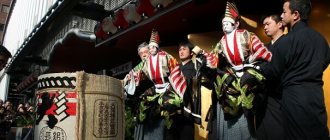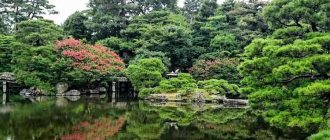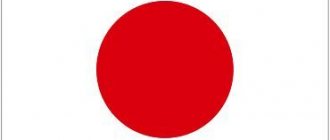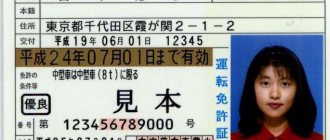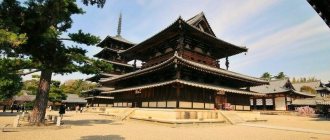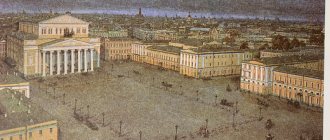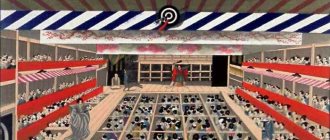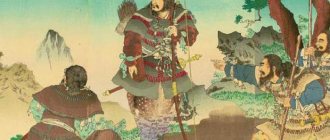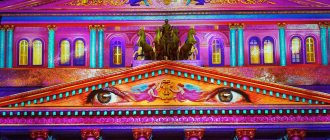Historical reference
History dates the emergence of national theatrical art in Japan to approximately the 7th century. It came from neighboring countries of the East: from Chinese, Korean, Indian, Persian, Tibetan expanses. In many ways, theatrical performances of that time are associated with religious beliefs: shamanism, Taoism, Confucianism, the Shinto religion, but most of all with Buddhist teachings.
Two types of art came to Japan first:
- gigaku - pantomimes;
- Bugaku - dancing.
They were performed during religious festivals, folk festivals, and later won a separate stage, becoming a kind of theater. Gigaku existed until the 10th century, but then it was overthrown from the theatrical stage by other, more sophisticated types of pantomime. Bugaku still exists.
Theatrical talents were passed on from generation to generation: often the children of actors inherited their profession, and a whole dynasty was formed. Thanks to this, the whole world can get acquainted with the masterpieces of this art and get to know the original Japanese soul through the prism of theater.
Related materials:
Editor's Choice: September | adult fairy tales | national holiday | cities of Russia | cultured people | cultural capital | modern Art
Articles
- My trip to India: Goa. Part 3 February 26, 2013, 19:00
- Red thread: Kimika Hara July 19, 2014, 18:00
- Provincial stories. About the Leningrad poetess, the exiled bell and the “Seagull” watch September 07, 2021, 18:00
Video
- Idylle by Guerlain. History of creation October 25, 2011, 11:03
- Video report from the 3rd Birthday of ETOYA.RU! November 18, 2011, 10:58
- Birthday of the ILE DE BEAUTE store in St. Petersburg at the French Boulevard shopping center September 21, 2012, 12:00
Types of Japanese theater
Traditional Japanese theater has remained virtually unchanged for centuries. The only transformation is that the performance now lasts much less - about 2 hours instead of 5-6, and the scenes themselves, the characters, and the events have become more dynamic.
There are several types of theater that are beloved in Japan:
- But, he is also Nogaku - performances for the aristocratic strata;
- Kyogen - crowd theater, showing comedy scenes from the lives of ordinary people;
- Kabuki is for ordinary people;
- Bunraku - puppet theater;
- shadow play.
Of course, modernity dictates its own rules, and today in Japan you can even enjoy modern ballet or listen to opera. However, foreign tourists, and even the residents of the country themselves, want to touch the eternal - traditional theater.
Noh Theater
Noh theater originated in the 14th century and became especially popular during the time of the famous samurai Tokugawa. So traditionally it became a genre of samurai, rulers and aristocratic persons.
Its highlight is the special masks and national kimono costumes that the actors wear. The mask does not correspond to a specific character - it is used to express feelings, emotions, mood, so one actor can wear several masks in turn. Both masks and costumes are passed on from senior actors to junior ones within the theater.
In Japanese theaters, about 200 masks made of cypress wood have been preserved, which have existed for centuries.
During the performance, the site - the main character - talks about his life, about times of peace and war, love and family experiences, criminal acts, demonic manifestations and the opposition of evil to good. In the old patois, the site narrates the story, accompanied by calm music and a choir, and then the secondary characters join in.
Much attention is paid to gestures - they are graceful and elegant. The perception of the play depends on the specific viewer - he himself comes up with the meaning of many scenes. The performance lasts from three to five hours.
Some moments of Noh can be unexpectedly contrasting: melancholic dancing to rhythmic music or a bright climax of the plot during complete silence. The scenery is simple so as not to distract from the main thing - the acting.
Japanese theater: from time immemorial
Theater in the Land of the Rising Sun is an art that comes from a truly ancient past. The first to begin giving theatrical performances for religious purposes were the Shintoists, adherents of the religion that existed before Buddhism in Japan. The most interesting thing is that these “shamanic dances with a tambourine” called Kagura, quite simple, have survived to this day as a theatrical art! But the Japanese theater received its main impetus when Buddhism began to penetrate into Japan from China, Korea and India almost 1,500 years ago. Some historians believe that the pro-Greek states of Asia, India and Korea were also vehicles for ancient drama, one of the main “ancestors” of theater in the world...
Photo from kabar.kg website
Around the 7th century, Japan borrowed the art of Gigaku pantomime and Bugaku dances from the culture of its neighbors. Gigaku lived for a little over 300 years, since much more interesting and complex genres grew on its basis, but the art of dance was so popular with the imperial court that it existed until the Meiji restoration in 1868, when the shogunate regime was overthrown. It would seem that the old regime had fallen, but the art of dance, as a component of the traditional art of Japan, even experienced a second heyday during that period, and still represents the ancient theatrical traditions of Japan!
In the 14th century, two directions came to Japanese theater at once: the dramatic theater of masks Noh and the Kyogen theater. The first was intended for the nobility, the second was for the entertainment of the lower classes. At the beginning of the 17th century, the most famous Japanese theater in the world today, Kabuki, was born. In addition, from the traditional theatrical entertainment of old times, such trends as Jozuri and Yose have survived to this day. We will try to briefly tell you about each of these styles below...
Photo from the site ru.sputniknews-uz.com
Kyogen
Kyogen is not at all like Noh theater, although for a long time it was its sideshow, that is, a small comic scene within an exquisite performance of dramatic content. However, after World War II, Kyogen gained fame and began to function independently, apart from Noh.
Kyogen caters to a large crowd. This is a comedy, a farce, scenes from the life of ordinary people who are devoid of fateful events. The scenes are simple, full of trivial jokes and cases familiar to most people.
The themes of kyogen are:
- evil spirits;
- gods;
- family troubles;
- everyday fuss;
- male infidelity;
- female insidious nature.
A frequent hero of the Kyogen theater is the servant of Taro. There are many characters, and according to their importance they are divided into main, secondary, tertiary and beyond.
The most famous schools of Kyogen are called Okura and Izumi.
Women's and men's suits are used, and service suits are available separately. All of them are made according to samples of outfits from the 16th and 17th centuries. Sometimes masks can be used, but not to express the feelings of the characters, as happens in Noh theater, but as an element of costume - each hero has a specific mask.
Kyogen Theater
Japanese Kyogen theater is very different from its counterpart, Noh theater. But is a sublime drama, elegant and poetic, while Kyogen is a comedy, simple and prosaic. However, Noh and Kyogen coexist successfully on the same stage: short plays by Kyogen traditionally break up the Noh action, giving the audience the opportunity to relax and “switch” between dramas.
Kyogen, like other theaters in Japan, emerged from folk entertainment: during the Heian period (794 - 1185), folk farce with elements of acrobatics and clownery - Sarugaku - “monkey performances” or “monkey music” was popular. Traveling actors entertained the audience with various performances: juggling, stilt walking and magic tricks. Later they began to act out farcical scenes, improvising and accompanying the action with short monologues or dialogues. Sarugaku performances were a success, and the ministers of shrines and monasteries, in order to attract flocks, began to invite actors to perform at temples during public and religious holidays. Settled life at the temples allowed the actors to improve their skills, and soon sarugaku actors performed not only in front of ordinary people, but also in front of a decent, sophisticated audience.
During the Muromachi period (1336 - 1573), sarugaku merged with dengaku - various types of entertainment performances, from dancing to sword swallowing, derived from magical rites and village songs. The fusion of these two genres gave birth to Nogaku theater (a common name for Noh and Kyogen), which divided the performance into two parts - high and low style.
Currently, there are about two hundred Kyogen plays, each of which is aimed at making the audience laugh, while the weapon of Kyogen is not poisonous sarcasm or evil ridicule, but the naivety and stupidity of the character, his vitality. The heroes of the plays are very different: a master and a servant, a cunning salesman, a grumpy wife, a lazy monk - in general, ordinary people. There are also animals, demons or gods in the plays. However, not a single character, even if he is a liar or a thief, is an absolute villain.
Kyogen is perhaps the most understandable Japanese theater for a European - some plays can be understood even without knowledge of language, philosophy and history. For example, the ancient farce “Bound to a Stick”: The master, fearing that the servants will drink sake in his absence, ties one man’s hands behind his back, and ties a stick to the other’s shoulders. But the cunning servants, after some torture, manage to get each other drunk. Or the play “Three Cripples,” where the Master, for the sake of a good cause, decides to hire cripples for service. True, instead of real cripples, three crooks come to him, pretending to be blind, lame and dumb, who, in the absence of the Master, instead of guarding the goods, climb into the cellar, get drunk, dance and sing.
The constant rule of the Kyogen theater, as well as other Japanese theaters, is family. That is, only a representative of an acting dynasty (nowadays there are only two Kyogen schools - the Okura clan and the Izumi clan), and male, can perform on stage, although women are not prohibited from going on stage, but this rarely happens. Sometimes girls play simple children's roles, such as monkeys, but this happens in cases where the actors' family has no sons or they are still too young to play in the theater. It is interesting that the role of a Kyogen actor begins with the role of a monkey - this role is played at the age of 3-4, but the most difficult one is the role of a fox, it is believed that it can be played truly well only by completely mastering the art of Kyogen.
As in Noh, Kyogen actors use masks in their performances, but they are not as important as in Noh and are the exception rather than the rule. The main means of expression of the Kyogen actor are movements and postures, as well as his voice, because the actor not only gives the lines of his character, he also depicts various sounds, for example, the sound of a saw or a flying stone. At the same time, there is simply no saw or stone on the stage, just as there are no scenery and props, neither small nor large - the actor must show the viewer through his performance that there is something, and the viewer, in turn, must believe it. The absence of any decorations or objects allows the viewer to use their imagination, and that is when the real performance begins - nothing will happen if the viewer does not believe.
Kabuki
Probably everyone has heard about the Kabuki theater, even outside the Land of the Rising Sun. It is considered one of the classical art forms of Japan. Translated, this name means “the art of singing and dancing.” It appeared in the 17th century, during the Tokugawa government, and is associated with the name of a specific girl named Izumono Okuni.
Monument to Izumono Okuni
She was a temple dancer and later moved to Kyoto. There she did not give up her hobby, on the contrary, she began performing along the river coast and on city streets.
Okuni improved her skills, introduced new elements with a touch of romance and eroticism, and wove folklore, legends, and poetry into her performances. Soon musicians joined her, and the girl’s success was stunning. This is how she gave birth to a whole art form.
Many ensembles began to copy the genre. They often included revealing outfits and erotic scenes. Men went crazy over the beauty and grace of the actresses and often fought among themselves.
The ruling elite did not like this trend, so they legally banned women from participating in theatrical performances. But this did not destroy Kabuki as a type - now exclusively male actors began to play there, embodying both women and men - this is the so-called wakashu-kabuki.
Of course, after 2 centuries the decree was abolished, but the tradition of playing roles by men remained - there are now many more of them than female actresses. Kabuki plots reflect important values and spiritual experiences:
- righteous and just life;
- the Buddhist law of karma, when good is rewarded, and evildoers very soon feel the consequences of their own bad deeds;
- respect for elders;
- life commitments;
- dreams, desires, personal goals.
Costumes play an important role - they seem to recreate the era of the 17th century. It is not customary to use masks - instead, actors apply skillful makeup in several layers, and also wear wigs.
Japanese Kabuki theater is fun for everyone!
For a long time, commoners had no opportunity to watch theatrical performances: there weren’t even any stages, not to mention a separate theater building. But at the beginning of the Tokugawa era, in the 17th century, the democratic Kabuki theater grew out of Shinto dance traditions. Its origins lie in the story of a girl who danced at a Shinto shrine in Izumo. Her name was Izumo-No Okuni, she was the daughter of a blacksmith. She was the first in Japan to dance for the common people outside a temple, on the streets of Kyoto and in a dry river bed.
She was admired by both commoners and high ranks; in chronicles she was described as the most beautiful girl, and her dancing style was called majestic. Gradually, Okuni began to add other religious dances to her repertoire, interspersing them with secular and romantic ones, and performed to the accompaniment of flutes, drums and other traditional instruments borrowed from the Noh theater. In addition, she combined poetry and folk ballads with dance and music, and as a result, the whole action resulted in Kabuki theater, which translates as “the art of singing and dancing”...
Photo from the site www.jtheatre.info
However, Kabuki also faced troubles. When Okuni and her troupe came to Edo, because of the beauty and grace of the dancers, the samurai whom they entertained fell madly in love with them, which, of course, led to the reaction of the authorities: they “closed the shop” by banning performances of the Kabuki theater in Edo. As art spread, the problem of "corruptive influences" soon arose everywhere in major cities. Then the authorities moved Kabuki away from the eyes of officials, to the city outskirts...
But this did not diminish the popularity of the theater; performances were always sold out, and in 1628 serious riots arose that disrupted the performance. As a result, in 1629 a decree was issued prohibiting women from participating in performances at all. This is how the tradition of onnagata appeared in Kabuki, when a man plays all roles: both female and male. This is exactly how Kabuki theater reached the end of the 19th century, when all such prohibitions were lifted, but women could no longer catch up with men in acting...
Photo from the site sushiwok.ru
You can visit the Kabuki Theater in Tokyo at this address:
Shadow play
Initially, shadow theater appeared among the ancient Chinese and Indian inhabitants 17 centuries ago. Later, with the raids of Genghis Khan, it entered the life of other Asian countries. In Japan, shadow art appeared around the 16th and 17th centuries, when theatrical performances were gaining momentum.
In the shadow theater, small plays were staged that reflected the usual life of the heroes, their experiences and eternal values. Each region of the country had its own theme.
For performances, a special design was used: a frame was built from beams, which was then covered with light canvas - this was the stage. The figures that became dolls were quite primitive - paper, leather, rags.
Actors were hiding behind the stage and controlling puppets using special ropes or thin bamboo sticks. The light was directed at the heroes, and they cast shadows on the white canvas-scene. Hence, as you may have guessed, the name of the theater. The dolls (or rather, the actors who controlled them) danced and sang.
Shadow theater is one of the most beloved in many eastern countries:
- the Chinese recreate the events of history;
- Indians stage scenes from the sacred epic Mahabharata;
- Turks love to enjoy comedy and farce.
Shadow theater in Indonesia
By the way, in one of the articles we talked about Chinese theatrical art - you can read about it here.
The Japanese base their performances on myths, legends, and folklore, and live actors dressed in black clothes perform alongside puppets - this approach makes Japanese shadow theater the most dynamic and realistic.
This year the Japanese shadow theater performed in Russia for the first time. This happened in Ulyanovsk at the “Japanese Spring on the Volga” festival.
Bunraku
Bunraku is a great entertainment for children and their parents, because it is a puppet theater and an enchanting musical performance in one package. Fairy-tale, mythical and folklore motifs come to life here.
The story began with the fictional princess Joruri, who became the main character of the ballads that formed the basis of the productions. At first there were no dolls - the monks performed songs, then the ensemble was supplemented by musicians, and the stories were accompanied by pictures. Only later were the images replaced with real figures.
The narrator is the main character, he is called gidayu here. It tells the story of events and also creates additional sound, such as creaking or rustling. The height of the dolls reaches one and a half meters.
In Bunraku, the puppets are controlled by actors in black robes with a hood - so they do not distract the audience from the magic happening on the stage.

